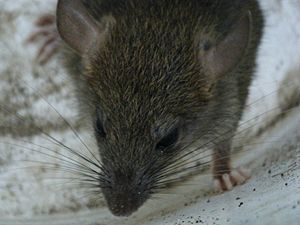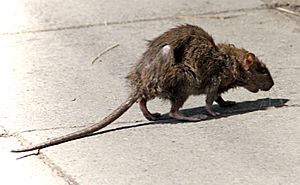Rat facts for kids
Quick facts for kids Rats |
|
|---|---|
 |
|
| Brown rat (Rattus norvegicus) | |
| Scientific classification | |
| Kingdom: | Animalia |
| Phylum: | Chordata |
| Class: | Mammalia |
| (unranked): | Glires |
| Order: | Rodentia |
Rats are medium-sized rodents with long tails. While many different kinds of rodents are called "rats," the most common ones belong to the group Rattus. Other types of rats include pack rats, bandicoot rats, and kangaroo rats.
Rats are usually bigger than mice. If a large rodent is called a "rat," a smaller one is often called a "mouse." There are 56 known species of rats around the world.
Contents
Types of Rats and What They Look Like
The most well-known rat species are the black rat (Rattus rattus) and the brown rat (Rattus norvegicus). These rats, sometimes called "true rats," first came from Asia. They are bigger than most mice but usually weigh less than 500 grams (about 1 pound) in the wild.
The word "rat" is also used for other small mammals that are not true rats. For example, North American pack rats (also called wood rats) and kangaroo rats are not true rats. Bandicoot rats are related to true rats but are not part of the Rattus group.
Male rats are called bucks. Unmated female rats are does, and pregnant or parent females are dams. Baby rats are called kittens or pups. A group of rats is known as a mischief.
Common rat species often live close to humans. They can sometimes eat a lot of food, especially in developing countries. However, most rat species are not pests. Many kinds of rats live only on certain islands. Some of these are now endangered because their homes are disappearing or because brown, black, or Polynesian rats have moved into their areas.
Wild rodents, including rats, can carry different germs that can make people sick. For example, the Black Death in the Middle Ages was thought to be spread by fleas that lived on black rats.
Rats can have babies when they are about 6 weeks old. However, they become socially mature around 5 to 6 months old. The average lifespan of rats varies by species. Many wild rats only live for about a year because other animals hunt them.
Rat Tails
The long tail of most rodents, like rats, has several important jobs. It helps them control their body temperature, helps them balance, and can even help them escape from danger.
A rat's tail is mostly hairless and has thin skin. It has many blood vessels that help the rat cool down or warm up. This is like how a car radiator works to keep an engine from overheating. The tail also has many muscles and bones. These help the rat know where its body is in space and keep its balance, especially when climbing or moving in tight spots.
Rats have a special defense called degloving. If a predator grabs a rat by its tail, the outer layer of skin can peel off. This allows the rat to escape, but it can also cause injuries.
Rats as Pets
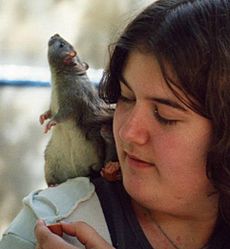
People have kept specially bred rats as pets since the late 1800s. Most pet rats are types of brown rats. However, black rats and giant pouched rats are also sometimes kept as pets. Pet rats act differently from wild rats, especially if they have been bred as pets for many generations.
Pet rats are not more likely to spread diseases than other pets like cats or dogs. Tamed rats are usually friendly. They can even be taught to do tricks!
People have bred rats to have different colors and markings. There are also rats with different fur types, like rex (curly fur) and hairless. Some rats, like the dumbo rat, have unique low, saucer-shaped ears. There are even standards for people who want to breed and show their rats at special rat shows.
Rats in Science
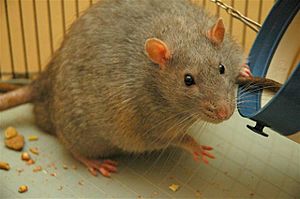
Since 1895, rats have been used in many scientific studies. They have helped us learn a lot about genetics, diseases, how drugs work, and other topics. This research has greatly helped human health.
Scientists often study rats to understand human health problems. For example, the heart and blood vessels of rats are similar to humans in some ways. This makes them useful for studying heart conditions.
Rats have also been important in studies about learning and how the mind works. They have helped scientists understand group behavior and what happens when too many animals are in one place. A study in 2007 found that rats can think about their own thoughts, a skill once thought to be only in humans and some primates.
Pet rats are different from wild rats in many ways. They are calmer and less likely to bite. They can live in crowded spaces better, and they have babies earlier and more often. Their brains, livers, kidneys, and hearts are also smaller than those of wild rats.
Brown rats are often used as model organisms in science. Scientists have mapped out much of the rat's genome (all its genetic information). This makes them a useful tool for genetic research, though mice are still more common. Rats are often chosen for studies on intelligence, learning, and drugs because they are smart, clever, and can adapt well. Their psychology seems similar to humans in many ways.
New types of brown rats, like the Wistar rat, have been created specifically for laboratory use.
Rat Intelligence
Early studies tried to measure how smart rats are. One way to do this is by using a T-maze, where rats have to find their way through a puzzle. Experiments in the 1920s showed that some rats were better at mazes than others. When these smart rats were bred, their babies were also better at mazes. This suggests that the ability to learn can be passed down in rats.
Rats as Food
Rat meat is eaten in some cultures, but not in others.
Working Rats
Rats have been trained to do many jobs. They can sniff out gunpowder, find landmines, act, and even help people in animal-assisted therapy.
Rats have an excellent sense of smell and are easy to train. For example, an organization called APOPO trains African giant pouched rats to find landmines and even detect tuberculosis by smell.
Rats as Pests

Rats have long been seen as harmful pests. They can cause a lot of damage and spread diseases. For example, in India, sometimes huge numbers of bamboo rats appear and eat everything in their path.
Most cities have problems with rat infestations. Rats can swim up sewer pipes and even into toilets! They will live anywhere they can find shelter, food, and water, like under sinks, near garbage, or inside walls.
Rats and Disease
Rats can carry germs that cause diseases like bubonic plague, Lassa fever, and Hantavirus infection. They can also carry mites that bite humans and cause skin rashes.
Rats as Invasive Species
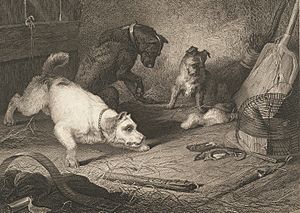
When rats are brought to places where they didn't live before, they can cause a lot of harm to the environment. The black rat (Rattus rattus), also called the ship rat, is one of the worst invasive species in the world. It has traveled all over the globe as a stowaway on ships. The similar species, the brown rat (Rattus norvegicus), also known as the wharf rat, has spread worldwide on ships in recent centuries.
These ship rats have caused many animals to become extinct, especially on islands. This includes birds, small mammals, reptiles, and even plants. True rats eat almost anything (they are omnivorous) and have many babies quickly. When they arrive in a new area, they reproduce fast and eat the local food supply. They especially prey on the eggs and young of forest birds. On isolated islands, these birds often have no other predators and are not afraid of rats. Some experts believe that rats are responsible for 40% to 60% of all seabird and reptile extinctions, with 90% of those happening on islands. This means humans have accidentally caused many extinctions by bringing rats to new places.
Rat-Free Areas
Rats are found almost everywhere humans live. The only continent without rats is Antarctica, which is too cold for them to survive outside. However, rats have been brought to many islands near Antarctica. Because they harm the native plants and animals, efforts are being made to get rid of them.
Some islands have successfully removed their rat populations to protect their natural environment. For example, Hawadax Island, Alaska was declared rat-free after 229 years, and Campbell Island, New Zealand after almost 200 years.
The Canadian province of Alberta is famous for being the largest inhabited area on Earth that is free of true rats. This is because of very strong government policies to control rats. Alberta does have native pack rats, but these are forest-dwelling vegetarians that cause much less damage than true rats.
Alberta was settled later than other parts of North America. Black rats cannot survive Alberta's cold climate at all. Brown rats need to live near people and inside buildings to survive the winters. There are also many predators in Canada's wild areas that eat non-native rats. It took until 1950 for invading rats to reach Alberta from Eastern Canada. As soon as they arrived at the eastern border, the Alberta government started a very strong rat control program. They used a system to find and get rid of rat infestations along a 600 km (370 miles) long and 30 km (19 miles) wide zone on the eastern border. They used shotguns, bulldozers, explosives, poison gas, and fire to destroy rats. Many farm buildings were destroyed in the process. At first, they used a poison called arsenic trioxide, but later they switched to warfarin, which is safer for people and better at killing rats.
Strong government control, public support, and people helping out continue to keep rat problems very low. A similar program in Saskatchewan also helps by stopping rats before they even reach Alberta's border. Alberta still has an armed "rat patrol" to control rats along its borders. About ten single rats are found and killed each year. Sometimes, a large group of rats has to be dug out with heavy machines. But there are no permanent rat infestations in Alberta.
Rats in Culture
Ancient Romans did not usually tell the difference between rats and mice. They called rats mus maximus (big mouse) and mice mus minimus (little mouse).
On the Isle of Man, there is a taboo against saying the word "rat".
Asian Cultures
The rat (sometimes called a mouse) is the first of the twelve animals in the Chinese zodiac. People born in the Year of the Rat are thought to be creative, intelligent, honest, generous, and ambitious. They are said to get along well with "monkeys" and "dragons."

In India, rats are seen as the vehicle (or ride) of Ganesha, a Hindu god. A statue of a rat is always found in a temple of Ganesh. In the city of Deshnoke, India, the rats at the Karni Mata Temple are believed to be holy. Priests feed milk and grain to the rats, and pilgrims also share the food.
European Cultures
In Europe, rats are often seen in a negative way. For example, saying "Rats!" can be a way to express frustration. This view might come from the idea that rats (and their fleas) were linked to the Black Death plague in the 14th century. Rats are sometimes seen as mean, dirty animals that steal food and spread disease. In 1522, rats in Autun, France, were even put on trial for destroying crops! However, some people in Europe keep rats as pets and find them to be tame, clean, smart, and playful.
Rats are often used in scientific experiments. Some people who support animal rights believe that the way rats are treated in these studies is cruel. The term "lab rat" is sometimes used to describe a person who spends a lot of time doing research.
Terminology
Rats are often blamed for damaging food and spreading disease. This has led to the word "rat" being used as an insult in English. It can mean someone who is dishonest or someone who tells secrets to the police. If someone "rats on" another person, they betray them by telling authorities about a crime. Describing a person as "rat-like" usually means they are not attractive and seem suspicious.
In trade unions, "rat" is also a term for employers who do not work with unions. This is why unions sometimes use inflatable rats at protests.
See also
- List of fictional rodents
- Rat-baiting
- Rat king
- Chicago rat hole


